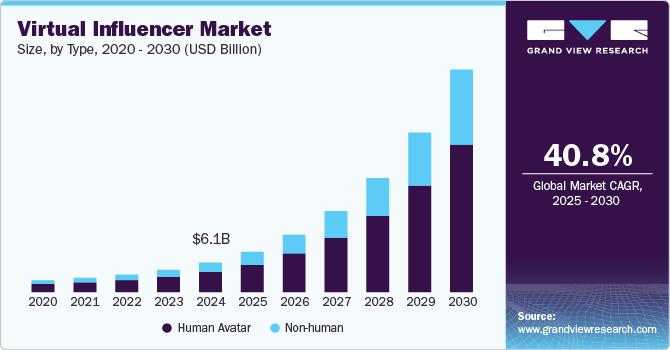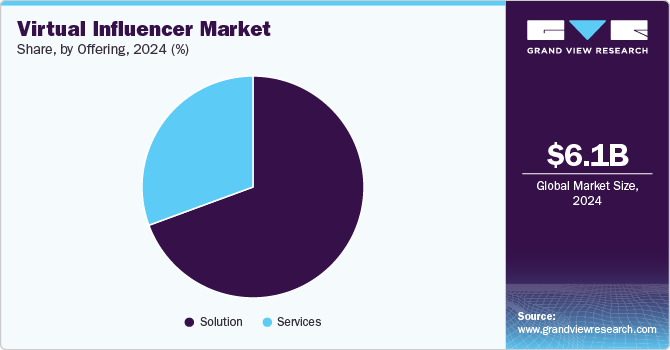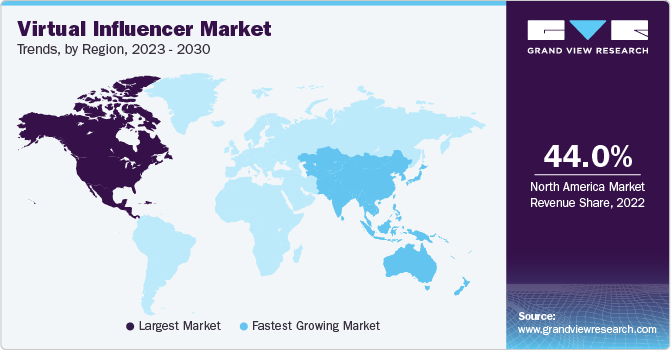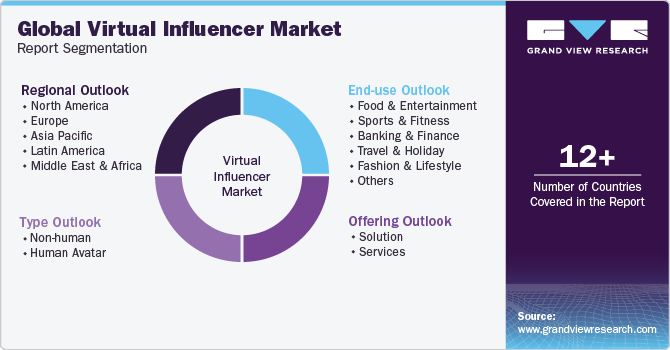
Virtual Influencer Market Size, Share & Trends Analysis Report By Type (Non-human, Human Avatar), By Offering (Solution, Services), By End-use (Food & Entertainment, Sports & Fitness, Banking & Finance), By Region, And Segment Forecasts, 2025 - 2030
- Report ID: GVR-4-68040-175-0
- Number of Report Pages: 150
- Format: PDF, Horizon Databook
- Historical Range: 2018 - 2023
- Forecast Period: 2025 - 2030
- Industry: Technology
Virtual Influencer Market Size & Trends
The global virtual influencer market size was estimated at USD 6.06 billion in 2024 and is projected to grow at a CAGR of 40.8% from 2025 to 2030. The market growth is largely driven by the increasing preference among brands for unique marketing strategies that leverage digital personas to reach expansive audiences. Additionally, technological advancements in artificial intelligence and 3D modeling is further enhancing the realism and functionality of virtual influencer industry, making them more appealing to consumers, which is expected to significantly boost market expansion.

The cost-effectiveness of virtual influencers compared to their human counterparts is another significant driver of the market. Brands can save on expenses related to accommodation, travel, and other logistical costs associated with real-life influencers while still achieving impactful marketing outcomes. The interactive and immersive experiences offered by virtual influencers help brands build stronger connections with their target audiences, which is essential in today’s competitive landscape. This shift towards digital personas not only allows for greater creative freedom but also enables brands to tailor their messaging to specific demographics effectively.
In addition, the rising demand for realistic and relatable virtual influencers that can connect emotionally with consumers is fueling the market growth. Brands across various sectors, particularly in fashion and lifestyle, have successfully utilized human avatars to promote their products on social media platforms, leading to increased engagement and brand loyalty. As technology continues to advance, the capabilities of human avatars are expected to improve further, solidifying their position as a preferred choice for many brands.
The emergence of unique and imaginative non-human avatars allows brands to differentiate themselves in a crowded marketplace. These digital personas can be designed without the limitations of physical reality, enabling limitless creativity and adaptability in marketing campaigns. As consumer preferences evolve towards more engaging and visually striking content, brands are likely to invest more in non-human influencers that capture attention and foster brand recognition, thereby driving virtual influencer industry’s expansion.
Moreover, services such as consultancy, analytics, content strategy development, and social media management are becoming essential for brands looking to optimize their use of virtual influencers. This trend highlights a shift towards a more comprehensive approach in leveraging digital characters as part of broader marketing strategies, ensuring that brands can effectively engage with their audiences while maximizing their return on investment, which is further propelling the virtual influencer industry growth.
Type Insights
The human avatar segment recorded the largest revenue share of over 68% in 2024. This growth can be attributed to the increasing demand for realistic and relatable virtual influencers that can connect with consumers on an emotional level. Human avatars are often designed to embody traits and aesthetics that resonate with target audiences, making them effective in brand storytelling and engagement. Furthermore, advancements in artificial intelligence (AI) and computer-generated imagery (CGI) have enhanced the realism of these avatars, allowing brands to create more authentic interactions that foster consumer trust and loyalty, thereby driving segmental growth.
The non-human segment is projected to register the fastest CAGR of over 42% from 2025 to 2030. This rapid growth is driven by the emergence and popularity of unique non-human avatars, which offer limitless design possibilities that capture consumer attention in a crowded digital landscape. Brands are increasingly leveraging these imaginative personas to differentiate themselves and create distinctive identities that stand out. The flexibility of non-human avatars also allows them to be utilized across various marketing campaigns, from entertainment to educational content, catering to diverse audience preferences.
Offering Insights
The solution segment dominated the virtual influencer industry and accounted for the largest revenue share in 2024, owing to the increasing demand for comprehensive and innovative marketing solutions that integrate virtual influencers into brand strategies. As businesses recognize the effectiveness of virtual influencers in enhancing consumer engagement and brand visibility, they are turning to solution providers that offer tailored services to streamline the implementation process. These solutions not only simplify the integration of virtual influencers into various marketing campaigns but also provide brands with creative freedom, allowing them to leverage unique digital personas that resonate with their target audiences. This growing reliance on specialized solutions has solidified the segment's dominance in the market.

The services segment is expected to register a considerable CAGR from 2025 to 2030, driven by the increasing complexity of managing virtual influencer campaigns. As brands seek to maximize their return on investment, they are increasingly relying on specialized services such as consultancy, analytics, and reporting. These services help brands effectively create and manage virtual influencers while leveraging advanced technologies to engage audiences across multiple platforms. The rising demand for data-driven insights and performance metrics is further propelling growth in this segment, as brands aim to optimize their marketing strategies through expert guidance and innovative service offerings.
End-use Insights
The fashion & lifestyle segment accounted for the largest revenue share 2024, primarily driven by the increasing popularity of virtual influencers as trendsetters and brand ambassadors in these industries. Virtual influencers are particularly effective in promoting a wide range of products, such as clothing, accessories, and beauty items, as they embody the aesthetics and values that resonate with target audiences. Their ability to create immersive narratives and engage consumers through storytelling enhances brand recall and fosters a deeper connection with the audience, thereby fueling market growth.
The food & entertainment segment is anticipated to record a significant CAGR from 2025 to 2030, driven by the growing demand for engaging content that resonates with younger audiences. Virtual influencers are being utilized to host interactive cooking shows, promote food products, and create buzz around entertainment events, effectively bridging the gap between brands and consumers. This segment's appeal lies in its ability to create memorable experiences through storytelling and immersive content that captures the interest of digital-savvy consumers. As brands increasingly recognize the potential of virtual influencers to enhance their marketing strategies in the food and entertainment sectors, this segment is expected to experience substantial growth.
Regional Insights
North America virtual influencer market dominated the industry with a revenue share of over 42% in 2024. This growth is driven by rapid advancements in artificial intelligence (AI) and computer-generated imagery (CGI), which enable the creation of highly realistic and engaging digital personas. As brands increasingly seek innovative marketing strategies to connect with tech-savvy audiences, virtual influencers have emerged as cost-effective alternatives to traditional influencers, allowing for tailored content that aligns with brand values.

U.S. Virtual Influencer Market Trends
The U.S. virtual influencer market held a dominant position in 2024. Brands are increasingly focusing on authenticity and sustainability in their marketing efforts, leading to the development of virtual influencers that resonate with socially conscious consumers is propelling market growth in the U.S
Europe Virtual Influencer Market Trends
The Europe industry for virtual influencer is expected to grow at a considerable CAGR of over 41% from 2025 to 2030, driven by the increasing demand for innovative marketing strategies and the rapid evolution of digital technologies. Brands are leveraging virtual influencers to create hyper-personalized content that resonates with diverse consumer preferences, enhancing engagement and brand loyalty. The integration of AI and deep learning technologies allows for real-time interactions and adaptive behaviors, making virtual influencers more dynamic and relatable.
The UK virtual influencer market is expected to grow rapidly in the coming years. The trend towards using AI in influencer marketing is also gaining momentum, as brands explore the potential of virtual reality influencers created through advanced 3D modeling. This shift reflects a broader acceptance of virtual personas among consumers, particularly Gen Z and Millennials, who are increasingly drawn to authentic and creative digital content.
The virtual influencer market in Germany held a substantial market share in 2024, driven by an increasing recognition of mental well-being within fitness programs. Virtual influencers are being integrated into fitness apps to provide personalized workout content and wellness guidance, enhancing user experiences and attracting broader audiences. Additionally, the fashion sector in Germany is leveraging virtual influencers for targeted marketing campaigns, allowing brands to tailor their messaging while maintaining creative flexibility.
Asia-Pacific Virtual Influencer Market Trends
The Asia Pacific virtual influencer market is expected to grow at the fastst CAGR of over 44% from 2025 to 2030, primarily driven by the increasing demand for innovative marketing strategies and the rapid adoption of social media platforms. As brands seek to engage digital-savvy consumers, virtual influencers have emerged as effective tools for brand endorsements and storytelling. The fashion and beauty industries, in particular, have embraced virtual influencers as trendsetters, leveraging their ability to showcase products and create immersive narratives that resonate with audiences.
The Japan virtual influencer market is expected to grow rapidly in the coming years. The market is driven by a cultural affinity for digital characters and storytelling. Virtual influencers in Japan are not only used for marketing but also play significant roles in entertainment, often participating in virtual events and collaborations with real-world brands.
The virtual influencer market in China held a substantial revenue share in 2024. The rise of hyper-realistic virtual influencers, such as Ayayi, reflects a trend towards blending physical and digital experiences through innovative brand concepts. Brands are increasingly utilizing these digital personas to promote products across various sectors, including fashion and entertainment. Furthermore, the Chinese government's support for the food and entertainment industry is fostering an environment conducive to the expansion of virtual influencers, allowing them to cater to evolving consumer preferences in urban areas.
Key Virtual Influencer Company Insights
Some of the key players operating in the market include Superplastic and Dapper Labs.
-
Superplastic is an entertainment brand that specializes in creating and managing a diverse roster of animated synthetic celebrities and virtual influencers. Superplastic combines the worlds of designer toys, digital collectibles, and animated content, aiming to build a Disney-like metaverse for the NFT age. The company is at the forefront of the virtual influencer market, engaging audiences through innovative storytelling and character-driven experiences.
-
Dapper Labs, Inc. is a pioneering technology company focused on creating engaging digital experiences through blockchain technology and NFTs (non-fungible tokens). Known for its innovative products like NBA Top Shot and CryptoKitties, Dapper Labs aims to connect people by enabling them to collect, trade, and own unique digital assets. The company emphasizes the importance of decentralization, allowing creators and brands to build meaningful interactions within the digital landscape.
Some of the emerging market players in the virtual influencer market include UneeQ Limited and Soul Machines.
-
UneeQ Limited specializes in creating digital humans for customer engagement across various industries. Their technology allows brands to deploy virtual influencers that can interact with customers, enhancing user experience and brand connection.
-
Soul Machines is a pioneering company in the field of digital humans, utilizing advanced artificial intelligence to create lifelike avatars that can interact with users in real-time. The company focuses on developing emotionally responsive digital characters that can be used across various industries, including entertainment, customer service, and education. By combining neuroscience with cutting-edge graphics and AI, Soul Machines aims to revolutionize human-computer interaction and enhance the way brands connect with consumers through virtual influencers.
Key Virtual Influencer Companies:
The following are the leading companies in the virtual influencer market. These companies collectively hold the largest market share and dictate industry trends.
- Epic Games, Inc.
- Pinscreen Inc.
- Soul Machines
- NEON
- Superplastic
- Dapper Labs, Inc.
- UneeQ Limited
- Didimo Inc.
- Spatial Systems, Inc.
- DeepBrain AI Inc.
- REBLIKA
- Ogilvy
- Cafegroup
Recent Developments
-
In July 2024, UneeQ Limited announced its participation in SIGGRAPH 2024, where it held the first-ever speaking session co-presented by an AI-powered digital human named Sophie. This interactive avatar, one of the first digital humans in the world, shared the stage with Marco Chavira, VP Sales USA at UneeQ, responding to questions in real time.
-
In June 2024, UneeQ Limited announced a significant collaboration with NVIDIA at COMPUTEX 2024, integrating its advanced digital human solutions with NVIDIA ACE technology. This partnership aims to enhance the lifelike capabilities of digital humans, enabling more accurate information delivery and improved user interactions.
-
In May 2024, Superplastic announced a strategic partnership with AREA15, which aimed to introduce its animated characters into the real world for the first time. This collaboration involved the opening of an experiential space within AREA15.
Virtual Influencer Market Report Scope
|
Report Attribute |
Details |
|
Market size value in 2025 |
USD 8.30 billion |
|
Revenue forecast in 2030 |
USD 45.88 billion |
|
Growth rate |
CAGR of 40.8% from 2025 to 2030 |
|
Base year for estimation |
2024 |
|
Historical data |
2018 - 2023 |
|
Forecast period |
2025 - 2030 |
|
Quantitative units |
Revenue in USD million/billion and CAGR from 2025 to 2030 |
|
Report coverage |
Revenue forecast, company ranking, competitive landscape, growth factors, and trends |
|
Segments covered |
Type, offering, end-use, region |
|
Regional scope |
North America; Europe; Asia Pacific; Latin America; Middle East & Africa |
|
Country scope |
U.S.; Canada; UK; Germany; France; China; Australia; Japan; India; South Korea; Brazil; Mexico; South Africa; Saudi Arabia; UAE |
|
Key companies profiled |
Epic Games, Inc.; Pinscreen Inc.; Soul Machines; NEON; Superplastic; Dapper Labs, Inc.; UneeQ Limited; Didimo Inc.; Spatial Systems, Inc.; DeepBrain AI Inc.; REBLIKA; Ogilvy; Cafegroup |
|
Customization scope |
Free report customization (equivalent to up to 8 analyst’s working days) with purchase. Addition or alteration to country, regional & segment scope. |
|
Pricing and purchase options |
Avail customized purchase options to meet your exact research needs. Explore purchase options |
Global Virtual Influence Market Report Segmentation
This report forecasts revenue growth at global, regional, and country levels and provides an analysis of the latest technology trends in each of the sub-segments from 2018 to 2030. For this study, Grand View Research has segmented the global virtual influencer market report based on type, offering, end-use, and region:

-
Type Outlook (Revenue, USD Million, 2018 - 2030)
-
Non-human
-
Human Avatar
-
-
Offering Outlook (Revenue, USD Million, 2018 - 2030)
-
Solutions
-
Services
-
-
End-use Outlook (Revenue, USD Million, 2018 - 2030)
-
Food & Entertainment
-
Sports & Fitness
-
Banking & Finance
-
Travel & Holiday
-
Fashion & Lifestyle
-
Others
-
-
Regional Outlook (Revenue, USD Million, 2018 - 2030)
-
North America
-
U.S.
-
Canada
-
-
Europe
-
UK
-
Germany
-
France
-
Italy
-
Spain
-
-
Asia Pacific
-
China
-
India
-
Japan
-
South Korea
-
-
Latin America
-
Brazil
-
Mexico
-
Middle East & Africa
-
South Africa
-
Saudi Arabia
-
UAE
-
-
Frequently Asked Questions About This Report
b. The global virtual influencer market size was estimated at USD 6.06 billion in 2024 and is expected to reach USD 8.30 billion in 2025.
b. The global virtual influencer market is expected to grow at a compound annual growth rate of 40.8% from 2025 to 2030 to reach USD 45.88 billion by 2030.
b. Based on type, the human avatar segment dominated the market in 2024 with a share of over 68% due to the increasing demand for more realistic and relatable virtual influencers, as human avatars can connect with consumers on an emotional level.
b. The key players in this industry are Epic Games, Inc., Pinscreen Inc., Soul Machines, NEON, Superplastic, Dapper Labs, Inc., UneeQ Limited, Didimo Inc., Spatial Systems, Inc., DeepBrain AI Inc., REBLIKA, Ogilvy, and Cafegroup.
b. Key factors that are driving the virtual influencer market growth include the continuously evolving digital landscape and rising usage of social media around the globe are fueling the market’s growth.
We are committed towards customer satisfaction, and quality service.
"The quality of research they have done for us has been excellent."




